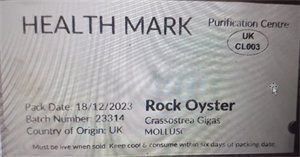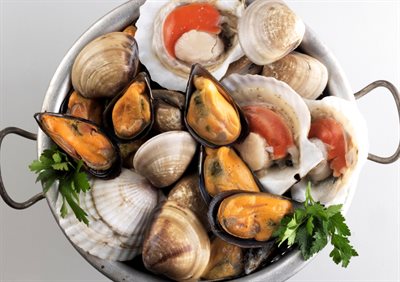Guidance on handling of live oysters at retail and catering outlets
Handling and serving live oysters is different to handling and serving other ready-to-eat foods. You need to ensure that shellfish remain alive until either eaten or cooked so the quality does not start to deteriorate.
Where shellfish is eaten raw, it is likely that the main health controls will have occurred at the purification and dispatch centre, so it is important that you handle the products safely. In the event of an incident or recall it is essential to be able to trace oysters back to the dispatch centre, allowing individual oyster beds to be closed, if necessary, to reduce further illness to consumers.
These notes will help you to maintain traceability and maintain your oysters in the best condition to keep you and your customers happy.
 Traceability All packages of live oysters must be accompanied by a dated health/ID mark on an indelible, water-resistant label like the one shown on the left.
Traceability All packages of live oysters must be accompanied by a dated health/ID mark on an indelible, water-resistant label like the one shown on the left.
This label shows the identification number of the establishment from which they have come (in the oval shape), a batch number, date of packaging and declaration that animals must be alive when sold.
Alternatively, a minimum durability date could be used. These details should be sufficient to identify the actual bed from which the oysters were harvested.
To comply with shellfish legislation, you MUST keep the health mark details for at least 60 days in case this information is needed. The easiest way to do this is to affix the label into your diary on the day of delivery.
Try to avoid using oysters from different suppliers at the same time, but if this is unavoidable, you will need to devise a system of identifying which batch has been served to which customer if numerous batches or suppliers are used. This is essential in tracing back affected oysters causing illness.
Reception/delivery
Check that:
- the packages of oysters are closed & labelled as above. If there is no label bearing the required information attached to the packaging, reject the consignment.
- Where possible, that the vehicle is clean and that the oysters have not been mixed with raw fish or kept in hot and dirty conditions.
- The oysters are alive. If they are not tightly closed or do not rapidly close tightly when tapped, they are dead and should not be used even if to be cooked. Any with a broken or cracked shell should also be discarded.
Storage
- Always store the oysters with the curved (convex) side downwards – ‘cup down’. This helps to retain any fluid from oysters which
 may have opened within the shell and will assist in keeping them alive.
may have opened within the shell and will assist in keeping them alive.
- Store the oysters in a deep bowl (to prevent leaks) or in the box supplied, covered with a clean, damp, disposable cloth away from open foods. To avoid cross contamination, do not store below raw meat or fish.
- Keep them cool in the fridge (ideally 4°C – 8°C). These are live animals and must not be frozen.
- Do NOT re-immerse oysters in water. They will have been properly purified at the depuration centre, if necessary, and any further immersion risks re-contaminating them.
- Do not seal live oysters in an airtight container - they will not be able to breathe and will die.
- Do not store or display on ice – they may die due to ice causing cold shock and this also risks re-immersion as the ice melts. Also, do not store on seaweed or other foods which may cause contamination.
Handling
- Wash and dry your hands thoroughly using warm soapy water before handling and opening the oysters.
- Ensure that the knives and other equipment used for opening the oysters have been cleaned and disinfected before you start. If you use gloves or cloths, ensure that these are clean.
- Check that the outside shells of the oysters are clean and avoid pushing any mud or bits of shell into the oyster as you open it.
- Use a cleaned and disinfected or different shucking knife for each batch.
- Serve promptly. Ideally only shuck oysters to order.
There should be a separate area in the kitchen specifically for oyster preparation. If this is not practical, ensure that preparation takes place in a section of the kitchen which has been cleaned and disinfected before and after use. You must not prepare any ready to eat food nearby when oysters are being shucked. Dedicated equipment for oysters must also be used. Norovirus is often associated with raw oysters, and the use of your disinfectant contact time may need to be increased – e.g. for D10, the contact time is 5 minutes to kill viruses.
Service/Menu selection
During winter months, due to the prevalence of norovirus infections in the UK and the increase in the number of incidents of foodborne illness associated with consumption of raw shellfish, it is recommended that all shellfish is cooked and not eaten raw.
Food Safety Management
Make sure staff are trained in how to handle and store shellfish. Ensure that your written food safety management system is completed to cover shellfish storage, handling, preparation, and cooking, including which batch codes have been served to which customers.You may want to consider including a warning on your menus of the risk of illness from consuming raw oysters.
Food Handlers / Customer Illness
It is important to ensure that any food handlers suffering from gastrointestinal illness are excluded from any work relating to food handling duties and that they cannot enter a food handling area. This exclusion is usually for 48 hours after an individual no longer shows symptoms of illness. This is particularly important when handling products that are served raw, such as oysters.
Bacteria and viruses can still be found in someone’s faeces after symptoms stop. People must therefore be excluded for at least 48 hours after they stop showing symptoms of sickness/diarrhoea. Please ensure that a return to work interview has been completed for any staff member returning after illness, including a check on the last day and time of symptoms.
Sometimes customers or staff may be ill in your premises and it is important to clean up properly afterwards to prevent the spread of infection. Your usual cleaning routines may not be sufficient to do this effectively. Further guidance can be found on correct methods by clicking here.
In the event of your customers informing you that they have been ill as a result of eating at your premises, please contact us as soon as possible. It will be helpful to provide full contact details of the customer/s, the date and time of their visit as well as your supplier details and relevant batch codes.
Further Information
For further information or to report illness or complaints, contact SRS's Food Safety Team on: 0300 123 6696 or Contact Us (srs.wales).
Information on oysters and other shellfish can be found at:
Details on the FSA's Food handlers’ fitness to work can be found
here.
Shellfish GB ‘How to open oysters’ video on YouTube.
Outbreaks of norovirus in raw oysters and their management | Food Standards Agency.